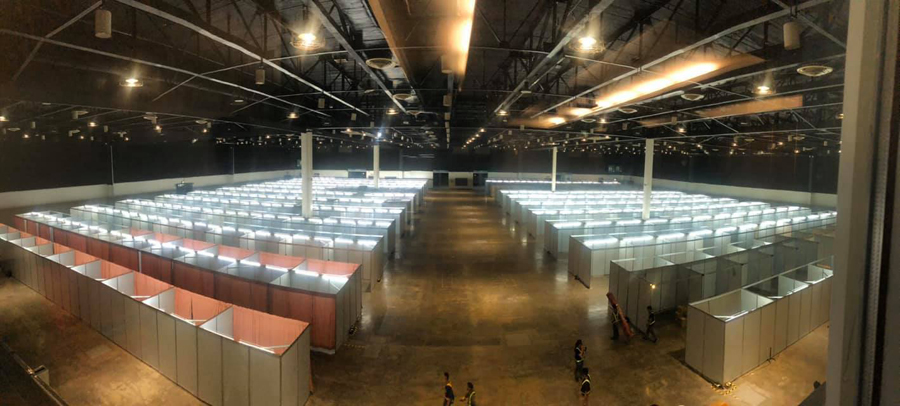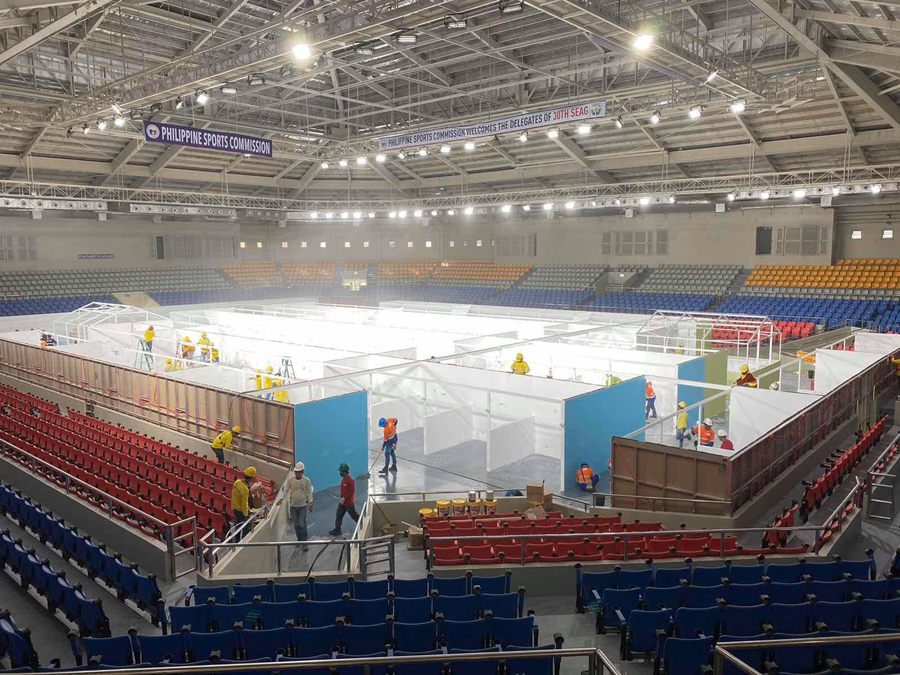Racing against time, the Philippine government and some of the biggest construction companies that are also members of the Philippine Constructors Association (PCA) pulled out all the stops to convert big sports coliseums and convention centers into emergency quarantine facilities (EQF) for the treatment and monitoring of COVID-19 cases.
The initial facilities that have been converted into EQFs and targeted to be all fully operational by the week of April 12 are the Rizal Memorial Coliseum, the Philippine International Convention Center and the World Trade Center.
The converted quarantine facilities where 24/7 medical care will be given are designed to make patients comfortable while ensuring the protection of the medical staff and other front liners according to standards set by the Department of Health (DOH). Aside from air-conditioned cubicles, free access to internet connection and electrical outlets, the facilities will also have food and water stations as well as sufficient toilets and showers.
Fast-tracking the work at the Rizal Memorial Coliseum with a 112-bed capacity are Prime Metro BMD and the Bloomberry Cultural Foundation Inc. under the Razon Group of Companies led by International Container Terminal Services Inc. (ICTSI) chairman and president Enrique Razon Jr. As the country targets to start mass testing this week, the facility is ready to accept COVID-19 patients who are asymptomatic and those displaying mild symptoms.
Work at the Philippine International Convention Center Forum Halls with a 294-bed capacity is spearheaded by the EEI Corporation of the Yuchengco Group of Companies in collaboration with Vista Land under the Villar Group of Companies. Construction work at the World Trade Center (WTC) is led by the Makati Development Corporation and other companies under the Ayala Group. This facility will have 502 beds.
Property company Ayala Land Inc. is also converting part of the Philippine Red Cross headquarters in Mandaluyong City into a testing facility that can process almost 3,000 COVID-19 tests per day with results that can be released in as fast as two hours.
PCA also pooled resources from the association, its regular and associate members as well as affiliate organizations to assist EEI Corporation in fast-tracking the installation and deployment of 60 emergency medical facilities or “smarthouses” that will be utilized by eight hospitals in San Juan, Mandaluyong, Manila, Quezon City, Antipolo, Santa Rosa in Laguna province and Batac in Ilocos Norte.

According to the PCA’s executive director Barry Paulino, their member-companies are one with the Philippine government in the fight against the pandemic. “As a nation builder, PCA is committed to working with the government in its COVID-19 response. Bayanihan (community spirit of cooperation) is a Filipino concept that we truly own and it now leads all of us to do our best in this great fight,” Paulino said.
Guiding the efforts for the conversion of the establishments into “instant hospitals” is the Department of Public Works and Highways (DPWH) under Secretary Mark Villar, with other private companies collaborating in the project such as Filinvest and Capital Corporation of the Philippines, Aboitiz Corp., Lina Group of Companies, PLDT and Smart, DM Consunji, Concepcion Industrial Corp. Boysen Philippines also partnered with the government to make the facilities color coded for enhanced protection of frontline workers. DM Consunji and Boysen Philippines are member of PCA.
Another PCA member, DATEM Construction, also put up the EQFs at the National Kidney Institute and the Philippine Army General Hospital. It is now working on a similar facility at the Ospital ng Makati. Will Decena and Associates also installed the EQF at the Mandaluyong Medical Center and the Lung Center of the Philippines.
President Duterte had signed into law Republic ACT 11469 granting him expanded but limited budgetary powers to step up the country’s fight against COVID-19. Under the law also known as the “Bayanihan to Heal as One Act,” the government can realign certain state funds to deliver Php200 billion (US$3.9 billion) in emergency subsidies to 18 million low-income households that have lost their sources of income amid the pandemic – the largest financial aid package ever granted to Filipino households – as well as special risk allowances and cash aid for public and private health workers in the frontlines, and the purchase of personal protective equipment and other measures.
The Philippine president has also extended the enhanced community quarantine for the entire island of Luzon to April 30 with strict social distancing protocols in place to fight the spread of the coronavirus disease with over 1.4 million cases and more than 82,000 deaths globally.
According to Finance Secretary Carlos Dominguez III, the government’s “Build, Build, Build” infrastructure program will fuel the country’s economic “bounce back.” PCA is now working on a plan to allow the industry to meet the challenge that may come whether the quarantine is lifted or modified.
Despite the pandemic, the Philippine government continues to aggressively pursue sustainable development measures, build major infrastructures and forge economic ties with diverse markets through solid economic fundamentals and a strong, resolute leadership consistent with the nation’s potential as the fastest growing economy in Asia.
Liked this post? Follow SwirlingOverCoffee on Facebook, YouTube, and Instagram.


